For the major part of my life, I have looked at food just as a mean to satisfy hunger. Nothing more. I have cared the least about the nutritional, seasonal, local and communal value of the foods I ate. It did not matter. While in school home-cooked meals were ones I frowned upon but ate without rebellion. College gave us the liberty to indulge in the street and fast foods while the food at the PG hostel was edible enough to take us through the day. While working with rural communities, we ate whatever we managed to find at those remote locations. Food was just a means to sustain. I wasn’t remotely inclined to learn why foods of certain communities tasted different, why we leaned towards certain kind of food, the onslaught of fast foods or the regional aspect of foods we ate. “I loved how you made this but we make it this way,” is how we discussed recipes with friends from other regions and communities. I never dwelled deep into the regional and communal aspects of our varied cuisines until I began blogging at theroute2roots. And what a journey it has been!!
The blog has helped me connect with numerous like-minded individuals who have generously shared their foodways here. I remember Aanalben writing “we are Anavil Desais, a community with a lot of passion for food and also a very strong cuisine of our own,” and would be happy to help me discover Anavil cuisine. Her words were music to my ears. She was quick to form a WhatsApp group, introduce me to her mum and we were ready to roll. All three of us were based in different countries (then) and eager to find a way forward. Covid derailed our plans for a year. But here we are with an introductory post on Anavil foods. The recipes have been cooked and shared with great enthusiasm by Rekha auntie while Aanalben introduces us to the Anavil community and its deeply rooted cuisine. And I cannot thank them enough for their willingness to be part of this journey (and the massive research Aanalben carried out to pen down the trailing writeup).
Aanal shares….
I was fortunate to grow up in an Anavil family, a community that prides itself to be foodies. One of my cousins and I joke that we like to talk and think about our next meal immediately upon finishing our current meal. Food is not only an obsession, we’re *very* particular and opinionated about our food.
Who are Anavils, you might ask? Anavils are a small brahmin community of landowners in south Gujarat that originally came from Afghanistan. They were the first settlers in the Surat and Bulsar area, clearing the land for agriculture in what happened to be a very fertile plain as many rivers originating in the Satpura plains drain into it. In the 17th and 18th centuries, Surat was the chief port of the Mughal Empire, and later it became an important base for the East India Company. The combination of exotic spices that were traded and the abundant vegetables and fruits that the Anavil agriculturists grew, led to the creation of a very distinct and unique sub-cuisine that is Anavil food. Anavil food fully utilizes the abundance of greens that grow in south Gujarat – fresh coriander and methi, leela adu marcha and lassan no masalo. For e.g. dhebras are usually filled with methi & leelo masalo (green masala) such that they are dark green in color compared to the dhebras (a kind of flat bread) that are brownish red with sukko masalo and a lot of wheat flour from north Gujarat. Leelu lassan (green garlic) in winter is something we especially await all year long as it goes into a lot of our winter preparations. We also use a lot of different techniques – we make a delicious farsan called Anavil or Desai vada with fermented flours or our batter for patra uses a mix of different flours and has an umami taste with a balance of sweet, sour, bitter and spicy. The patra is then cooked five different ways but more on that in a different post.
In the summer, mangoes are abundantly available all over Gujarat, including Kesar, Hafus, Langdo, my favorites Rajapuri and Totapuri and many other varieties. As a young kid, I remember climbing mango trees in my school’s compound to pluck green mangoes and after I got them home, my mom would peel and chop them into slices for me so I could dip them in salt and chili powder before wolfing them down. Every year, we would covet the arrival of a toplo or two of the most delicious Hafus (Alphonso) keri from my kakas’ farms in Valsad. My father loves mangoes immensely so in our house, ripe mangoes would be eaten for breakfast, lunch, dinner & as an afternoon snack. Some of the ways we enjoyed it was sliced with skin, peeled and cubed, as keri no ras (aam ras) with dhokla or patra, mango ice cream, in mango milkshake, gotla no ras (ras eaten directly from the mango after massaging and hand blending the flesh into pulp), keri nu raitu, and as keri ni kadhi. Green mangoes were also eaten raw as a snack or as aam pano or baflo and as a vaghareli chutney or in green chutney.
Talking about kadhi, Anavils make many many varieties of kadhi with seasonal vegetables. For example, in the winter from saragava na phool (drumstick flowers) or in the summer, this keri kadhi or kela ane phudina (bananas and mint) or saragava na paan (drumstick leaves) ni kadhi and in the monsoon season, kantoda (spiny gourd) or bhinda (lady finger) ni kadhi.
This keri kadhi is made in peak mango season when the best quality hafus (alphonsos) are available. Desi keri can also be used as an alternative, as it has smooth texture and is less fibrous. Anavils only make keri kadhi, not fajeto and my mom will vehemently say that the two are different but identifying the exact difference could be a never-ending argument as these recipes are all handed down from generation to generation and vary from family to family. Similarly, with keri kadhi, the 1965 Anavil cookbook called Pakshastra by Gajraben Manibhai Desai suggests adding whole red chilli and cumin seeds in the vaghar, along with sooth (dried ginger powder) and a now-forgotten ingredient called kada na phool. Kada na phool are the beautiful flowers of the Indrajau tree with a bitter and astringent taste, used in Ayurveda for their digestive, dosha balancing, and blood detoxification benefits. One foi (paternal aunt) mentioned that her grandmother used it a lot in cooking. Another foi just adds keri no ras in regular kadhi, while some people add mango bits for added texture, and others like my mom add the full gotlo (seed) after squeezing out the ras into the kadhi for added flavor and nutrition. Also, my mom is a very intuitive cook with exacting standards for taste so her recipe has variations such as the addition of black pepper and phudino (mint).
A common practice is to combine fangavela moth with kadhi as the flavors and the wet vs. dry consistency go well together so here, we present the two recipes together as a meal. Even for the moth, tradition can vary from family to family – my grandmother taught my two fois to make sukka fangavela moth with kadhi but one of foi’s in-laws combine fangavela moth and mung together. Usually, they are cooked until just done but my mother cooks them extra-long on low heat to give them a little crunch.
And now a little about my mom, Rekha Desai. She hails from a Vaniya family in Bombay and was blessed with a lot of natural talent for cooking. This allowed her, upon marriage, to fit right into my Dad’s Anavil family in Baroda and to my father’s delight, she picked up our cuisine very quickly just by watching my grandmother cook. These recipes come from her and were reproduced for exactness by Sheetal. My mom learnt them from my paternal grandmother, and like most Anavil home chefs used the book Pakshastra as her kitchen bible. My mom’s passion for food led her to organizing cooking classes for the women of Baroda in 1972 with More Dada, who was the chef of Raja Fatehsinhrao Gaekwad and in 2000, she was invited to be a Celebrity Chef by the local Holiday Inn where for 15 days the lunch and dinner menu was created with her recipes. She was one of the first people to make pizzas from scratch in Baroda when she moved there in 1964, and even today at 77, my father’s love for her food keeps her cooking these delicacies daily for him and for her two grandsons, who also relish Anavil food just as much. And for me, I work in the tech space in the US, and married into a Bhavnagri Prashnora Nagar Brahmin family. Luckily, I also inherited this love for food and cooking from my family and my mom & I are fortunate to have this partnership with Sheetal which has given us a wonderful opportunity to share our great cuisine with all of you. I would also like to express gratitude to all my aunts (Malvikafoi, Nalinikaki, Geetafoi, Akshayafoi, Varshafoi, and Gopalifoi) for help with research and imparting their knowledge of the Anavil foodways for this post.
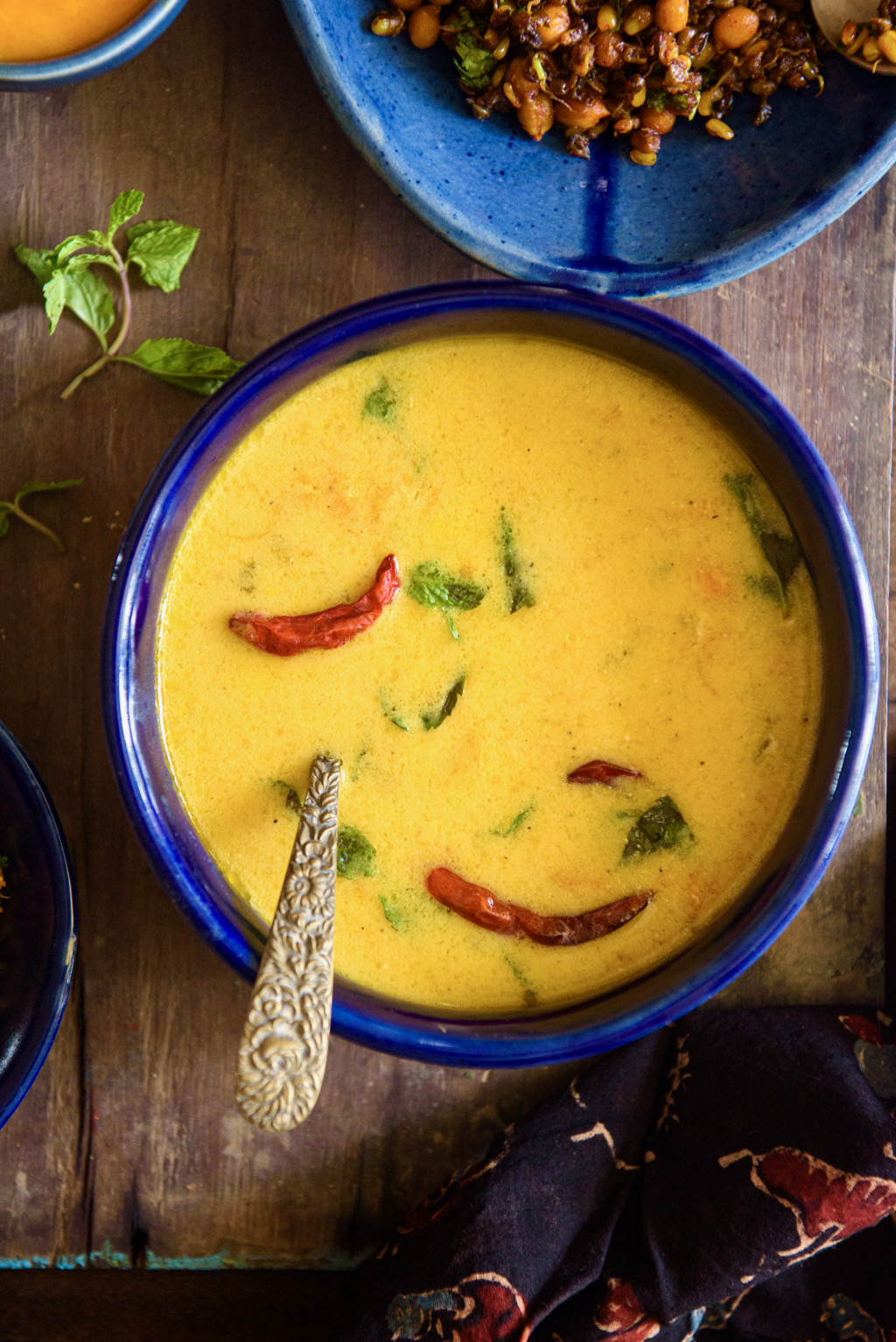
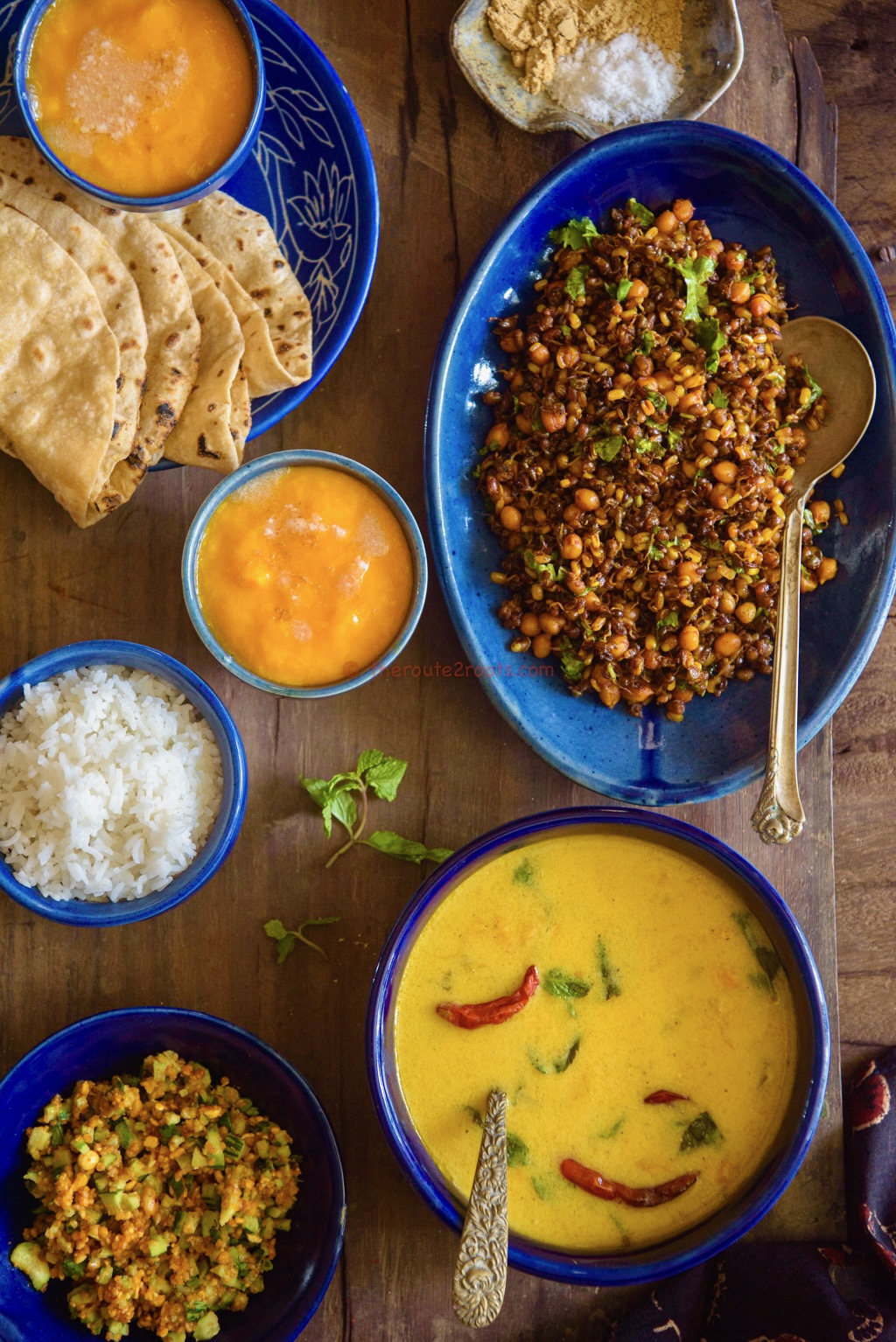
Paaki Keri Ni Kadhi - Ripe Mango Kadhi
Ingredients
- 8-10 pieces of chopped Alphanso Mango (any sweet mango would work well)
- 1/2 cup yogurt, plain
- 1/2 cup yogurt, sour
- 1.5 tablespoons besan/chickpea flour
- 1/4 cup mint leaves
- 2 teaspoons green chillies and ginger paste
- 1.5 teaspoon sugar
- 1/4 teaspoon black pepper powder
- 1/4 teaspoon asafoetida
- 1 inch stick of cinnamon
- 2 cloves
- 2-3 whole red chillies
- 1 tablespoon ghee
- salt to taste
Instructions
Using your finger tips mash the mango pieces.
Also squeeze the pulp off the mango seed/stone.
In a medium sized, heavy bottom sauce pan mix and whisk the curds so that it reaches smooth consistency.
Add the chickpea flour and mix it well until no lumps remain.
Add 3.5 cups water to the yogurt+ chickpea mixture.
Now go on to add the mashed mango pieces, the squeezed pulp and mango stone to the yogurt mixture.
Also add sugar, black pepper powder, green chilli+ginger paste, half the amount of mint and place the saucepan on medium flame.
Let the ladle remain in the sauce pan. It prevents the Kadhi from splitting.
Also do not forget to keep stirring or else the chickpea flour might settle at the bottom and burn.
Cook the kadhi till it has thickened a little. The consistency should neither be too thin nor thick.
Add salt.
In a tempering pan, heat ghee, add cinnamon, cloves, red chillies, asafoetida and quickly add the tempered ghee to Kadhi. To ensure you do not burn the whole spices keep the flame low.
Continue to cook the kadhi for few minutes more. Stir intermittently.
Turn off the flame, add the remaining mint leaves.
Serve hot with roti, rice and sprouted pulses.
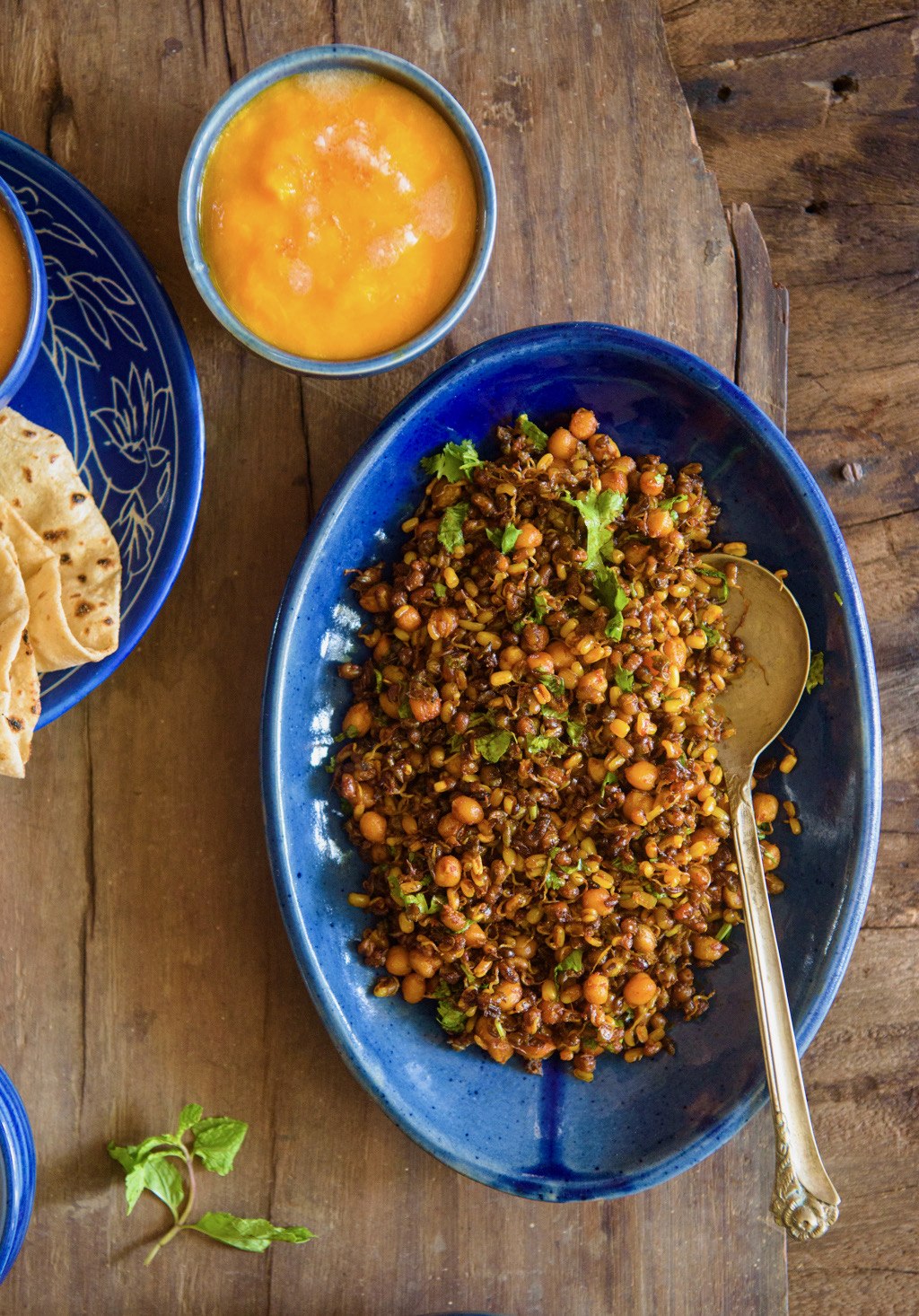
Sprouted Mung+Moth+Desi Chana
Ingredients
- 1/2 cup moong beans, sprouted
- 1/2 cup moth beans, sprouted
- 1/4 cup desi chana, sprouted
- 1/4 teaspoon asafoetida
- 1/4 teaspoon turmeric powder
- 1.5 teaspoon red chilli powder
- 1.5 teaspoon coriander and cumin powder
- 1/4 teaspoon sugar
- 3 tablespoons oil
- a pinch of baking soda (optional)
- salt to taste
- a squirt of lemon juice to balance flavours
Method
- Wash and drain all the sprouts well.
- Place a heavy bottom kadai on medium flame.
- Add the oil and asafoetida.
- Once the oil heats up add the sprouts.
- Cover and cook the sprouts on low flame until they are half cooked.
- After they are half done, add the spice powders and salt. Stir, cover and continue to cook.
- If you feel the sprouts are taking too long to cook, add a pinch of baking soda.
- Once the sprouts are cooked, add sugar. Mix well.
- Do not cover the sprouts, continue to cook. Stir occasionally. Keep the flame low.
- You want to crisp up the sprouts a little. Add a little crunch to it.
- Once done, turn off the flame and add some lemon juice.
- Enjoy hot with Kadhi and Rotli.


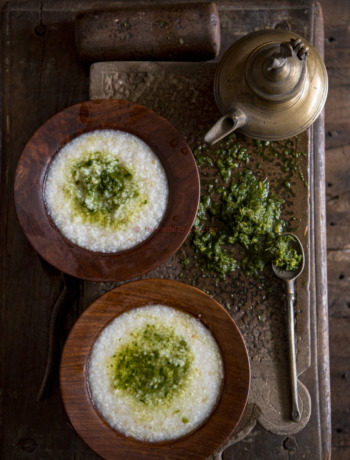
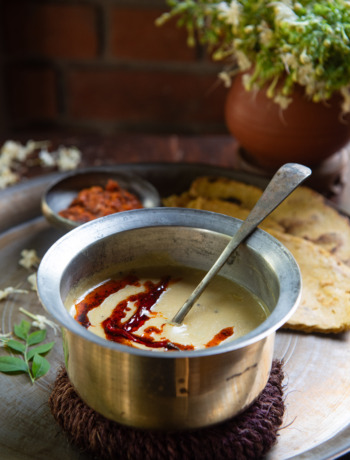
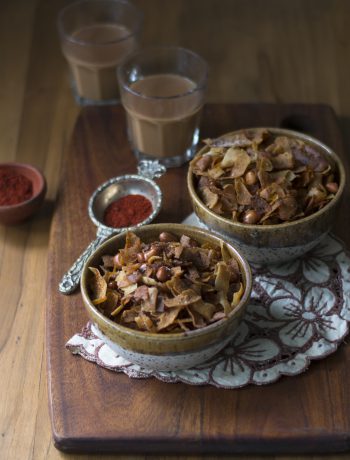
2 Comments
Bela
July 28, 2021 at 12:59 pmNice time see you back☺☺
Kalyani
April 8, 2023 at 5:11 pmChanced upon this recipe is Google as I was just relishing the Desai vada made by a friend here. And was curious to learn more .. a there it is – an extensive piece well written in the anavil Brahmin style of cooking .. keep them coming !
PS – the kadhi looks delish and am sure to tag you when I make it. I would prefer this to fajeto anyday